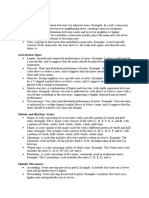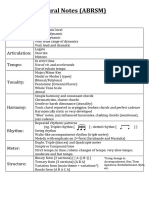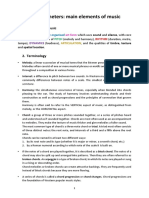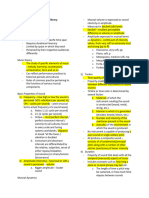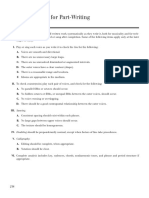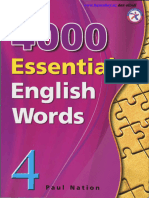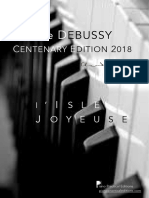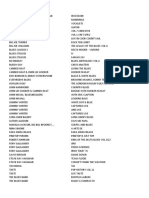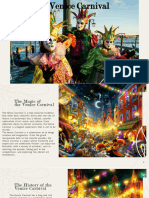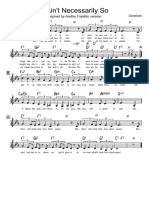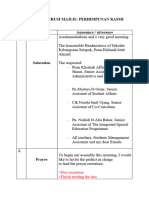GUIDELINES ACG000 ACG001 ACG002 ACG003 ACG004 ACG005 ACG006
Duration 1 min – 20 secs 40 secs–1 min 20 secs 50 secs–1 min 30 secs 1 min 10 secs–1 min 45 secs 1 min 30 secs–2 mins 1 min 45 secs–2 min 15 secs 2 mins – 2 mins 45 secs
(1 song)
Harmonic features Only 3 simple Chord types generally will not Chord types generally will not Chord types might extend to 7ths, Chord types might extend to 7ths, and Chords might occasionally extend Chords types might extend to 9ths
& chords: extend beyond triads, and tonality extend beyond triads, and tonality will be and tonality will be predominantly tonality will be predominantly beyond 7ths, and tonality may be
tonality G – Em - C will be predominantly diatonic predominantly diatonic, but there may be diatonic, but there may be occasional diatonic, but there may be occasional diatonic or based in a modal key centre.
occasional closely related non-diatonic closely related non-diatonic chords closely related non-diatonic chords Non-diatonic chords might occur more
chord frequently
Tempo 60-80 bpm 60–130 bpm 60-140 bpm 60-140 bpm 60-150 bpm 60-150 bpm 60-160 bpm
Time signatures 4/4 Simple time signatures, ie. 4/4, 3/4 Simple, or basic compound time 4/4 (straight or swung), 3/4, 2/4, 6/8, 4/4 (straight or swung), 3/4, 2/4, 6/8, 4/4 (straight or swung), 3/4, 2/4, 6/8, 4/4 (straight or swung), 3/4, 2/4, 6/8, 12/8.
signatures, ie. 4/4, 3 /4, 6/8 12/8 12/8 12/8. Time signature changes may occur There may be occasional time signature
very infrequently changes
Rhythmic values Dependent on Dependent on tempo: whole, half, Dependent on tempo: 8th notes and rests, Dependent on tempo: 16th notes and 16th notes and rests in more complex 16th notes and rests in more complex 16th notes and rests in more complex
tempo: whole, quarter, 8th notes and rests, occasional dotted 8th notes and rests, dotted 8th notes and groupings, 16th note syncopation, groupings, 16th note syncopation. groupings, occasional 32nd notes, 16th
half, quarter, 8th. occasional dotted half notes or syncopations, occasional 16th notes, and syncopations, occasional 16th note more frequent triplet groupings. Simpler rhythms appear in conjunction note syncopation. Simpler rhythms appear
dotted quarter notes very occasional non-complex triplet syncopation, non-complex triplet Simpler rhythms appear in conjunction with other elements (e.g. more detailed in conjunction with other elements (e.g.
No rests groupings groupings with other elements (eg. more harmonic work). There may be more detailed harmonic work). Triplet
detailed harmonic work) occasional triplet rhythm permutations rhythm permutations may be more
frequent
Dynamics None, or very None, or very simple/sparse Simple dynamics [P, F, MP, MF]. Subtle Simple dynamics [P, F, MP, MF], [P, F, MP, MF], crescendo (<) and [P, F, MP, MF], crescendo (<) and [P, F, MP, MF], crescendo (<) and
simple/sparse transitions will be very infrequent crescendo (<) and diminuendo (>) diminuendo (>) diminuendo (>) diminuendo (>)
Articulation & None, or very None, or very simple/sparse Simple changes in articulation and Frequent changes in Staccato can be more repetitive at this Articulation and phrasing will have more Articulation and phrasing will have variety
phrasing simple/sparse phrasing, occasional staccato articulation and phrasing, slurs and grade. Occasional hammer-ons, pull- variety. Staccato can be more and there may be subtle differentiation
simple use of staccato/accented offs and slides, which can be repeated predominant at this grade. Occasional between voices
articulation. Occasional hammer-ons, or extended hammer-ons, pull-offs and slides, which
pull-offs and slides can be repeated or extended points
Melodic features N/A Melodies will be predominantly Melodies will be predominantly diatonic Melodies will be predominantly Melodies will be predominantly Intervallic transitions over an octave Intervallic transitions over an octave may
diatonic Small intervallic transitions Small intervallic transitions in melody diatonic but chromatic notes may diatonic but chromatic notes may may occur, and chromatic notes may be more regular, and there may be more
in melody unless adjacent strings unless adjacent strings Passages will occur occur occur more frequently frequent non-diatonic notes
Passages will remain on single largely span adjacent strings
strings, or move at a slow tempo to
adjacent strings String skipping is
very minimal
Physical techniques Chords will largely be limited to Chords may feature 5 strings, or 6 strings Chords may feature up to 6 strings, Melodic passages can incorporate Melodic passages can skip strings more Melodic passages can skip strings more
three-string voicings, or occasional but with very simple fretting. ‘5’ chords including occasional simple major and basic string skipping and position frequently, and incorporate more frequently, and incorporate more frequent
four strings (if predominantly open) can be fretted. Harmonic rate of change is minor barre chord shapes. Harmonic shifts. Melodic work might be frequent position shifts Melodic work position shifts Melodic work might be
Harmonic rate of change is slow, moderate, giving time for preparation rate of change is moderate Melodic occasionally harmonised with thirds, might be harmonised with thirds, sixths harmonised with thirds, sixths or octaves
giving time for preparation Melodic passages will remain on single passages may move at a faster rate sixths or octaves Harmonic rate of or octaves Rhythmic groupings may Muting and legato techniques will be
Requirement for muting techniques strings, or move at a moderate tempo to between strings. String skipping may change is moderate but can include differ more frequently Muting and reaching an upper intermediate level
is minimal Passages only require an adjacent string. String skipping may feature more frequently Can be some more challenging sequences legato techniques might be more Variety in voicings and accompaniment
basic fingerstyle technique or picking occasionally feature. Melodic work might performed with plectrum or fingers, Rhythmic groupings may differ more frequent or pose some increasing styles within sections Simple alternative
technique be harmonised with occasional double unless stipulated Melodic work might frequently Muting and legato challenges Melody and accompaniment tunings
stops Basic muting techniques and very be harmonised with occasional 6ths techniques might be more frequent or voicings may appear in one part Variety
occasional simple slides or thirds Basic RH and LH muting, and pose some increasing but moderate in voicings and accompaniment styles
some legato techniques challenges within sections Capo may be used
Solo/development N/A N/A N/A N/A Open, solo or development sections Open solo or development sections are Open solo or development sections are not
are not obligatory, but if included not obligatory, but if included should obligatory, but if included should not
should not exceed 8 bars’ length as a not exceed 16 bars’ length as a guide exceed 16 bars’ length as a guide
guide.
Rhythmic features N/A N/A N/A N/A N/A N/A Rhythmic groupings may differ frequently;
faster note values may be more
repetitive/continuous
Song number 1
ACG FREE CHOICE PIECE GUIDELINES

